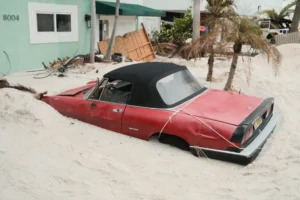
The Meaning Behind the ‘WC’ Sign: A Journey Through Bathroom Terminology
Have you ever noticed the letters WC outside a public restroom and wondered what they stand for? You’re not alone—people across the globe often puzzle over this cryptic abbreviation.
The Mystery of WC
Simply put, WC stands for water closet, a term historically used to describe a small room containing a toilet and sometimes a sink. While this might clarify the letters, it doesn’t exactly make the term feel more logical—similar to how “restroom,” “bathroom,” or “loo” can seem perplexing in their own right.
In 2020, a TikTok video featuring a couple named Shelby and Dylan hilariously highlighted the differences in bathroom terminology between Americans and Canadians. Walking past a sign reading washroom, Dylan quipped:
“What in the world is a washroom? And what are they washing in there? Oh, it’s a restroom. The only thing I wash in there is my hands.”
Shelby, off-camera, cheekily countered, “Do you rest in a restroom?”—to which Dylan admitted: “Good point. They both don’t make much sense.”
The video sparked a lively online debate about what to call the sacred space. Some commenters preferred “bathroom,” while others leaned toward “toilet,” “washroom,” or “restroom.”
One person humorously recounted a Disneyland visit where asking for the washroom led them to the laundromat. Another chimed in with, “Wait until he finds out about water closets.”
What Is a Water Closet?
According to Merriam-Webster, a water closet refers to “a compartment or room with a toilet” or “a toilet bowl and its accessories.”
Historically, the term reflects a time when specific rooms served distinct purposes. Bathrooms were for bathing, restrooms for resting or grooming, and the water closet for, well, using the toilet. As indoor plumbing became more common in the late 19th century, these spaces gradually merged into the modern bathroom we know today.
The water closet, however, often remained a separate, enclosed room in some homes and public spaces, particularly in Europe and international facilities. You’ll frequently spot the abbreviation WC in airports, hotels, or restaurants, catering to a globally diverse audience.
WC Across Cultures
Online forums like Reddit often dive into the quirks of global bathroom terminology. One post posed the question, Why is a public WC called a bathroom if there’s no bath?
A user responded:
“Americans might ask, ‘Why is it called a WC if it isn’t even a closet?’”
Others shared cultural takes:
- In Russian, it’s referred to as a room without windows, even if there’s a window.
- In Esperanto, it’s necesejo, meaning “necessary place.”
- Canadians frequently use washroom, which is also popular in parts of the U.S. Midwest.
Restroom vs. Bathroom vs. Washroom
The terminology debate continues, with many feeling washroom is the most logical since washing happens there. Meanwhile, terms like restroom or bathroom remain euphemisms.
One Redditor summed it up best:
“Best one, I think. You should be washing in there—not resting.”
What Do You Call It?
Whether you say WC, restroom, bathroom, toilet, or washroom, everyone has a favorite term. What’s yours? Share your thoughts, and don’t forget to spread this story to find out what others think!
Husband Ridicules Antique Egg Wife Purchased at Flea Market, So She Requests He Unwrap It

My husband once teased me for buying a small enameled egg at a flea market, but he was in for a surprise. I have always loved visiting flea markets, drawn to the idea of sifting through other people’s discarded items to find hidden treasures. This passion started when I was eleven, spending summers with my grandmother in New England. We would explore every flea market and street fair we could find, searching for what she called “preloved jewels”.
Even as a mother and grandmother now, nothing excites me more than rummaging through various stalls, hoping to find something special among the ordinary. My husband, Sam, is a kind and hardworking man, but he doesn’t understand my obsession. He often refers to my finds as “hoarder junk”, which sometimes causes tension between us. Despite his criticisms, I have no intention of giving up my weekend adventures with a budget of $20, determined to uncover a hidden gem.
Recently, Sam surprised me by asking to join me on one of my trips. It all started a month ago when I visited a nearby town’s street fair. I felt a thrill of excitement as I approached a modest display of knickknacks. Among the items was a small porcelain and enamel egg, roughly the size of a real egg. It wasn’t particularly beautiful, but I was drawn to it.
When I asked the seller how much it cost, he said $25. I gasped dramatically and offered him $5. After some back-and-forth, I convinced him to sell it to me for $10, and I felt a sense of victory as I tucked it away. After browsing a bit more, I headed home with my treasure in hand.
When I got home, I greeted Sam, who was skeptical about my find. He turned the egg over in his hands and discovered it was labeled “Made in Hong Kong”. He laughed and said I had been tricked. I felt a wave of disappointment but insisted that I liked it and heard something shifting inside.
With a quick motion, Sam pried the egg open, revealing a tiny bundle of red silk. As I carefully unwrapped it, I discovered a stunning pair of earrings nestled within. Although I initially thought they were just good fakes, Sam was convinced they were real diamonds after testing them with his breath, which didn’t fog up the clear center stone.
Excited, Sam suggested we take the earrings to a jeweler for appraisal. Despite my concern about the cost, we went to the mall, and the jeweler confirmed that they were indeed diamonds set in 18-carat white gold, possibly worth hundreds of thousands of dollars. My head spun when he said they could be valued at around three million dollars at auction.
Incredibly, the earrings sold for three million! We now have a lovely nest egg in the bank, and the porcelain egg proudly sits on the mantel of our new home. Sam, once a skeptic, has become an enthusiastic flea market companion, joining me in the hunt for more treasures. We may not have found that Van Gogh yet, but we remain hopeful!
This story teaches us that one person’s trash can truly become another’s treasure. It also reminds us to respect and support each other’s interests—Sam’s mockery of my hobby turned into appreciation when we discovered the earrings together.



Leave a Reply